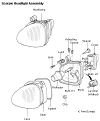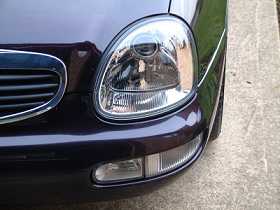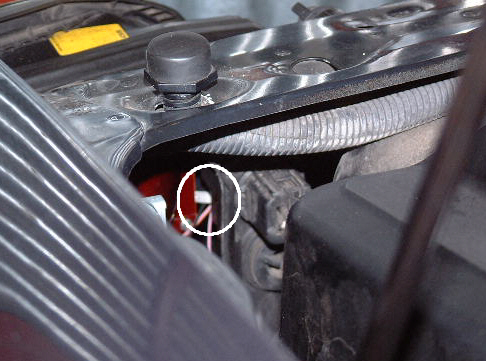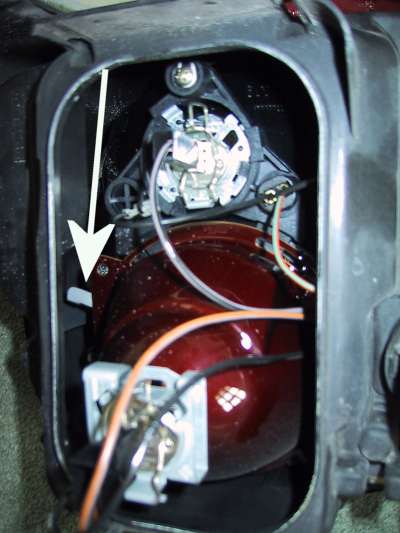Continental driving
Recently I received e-mails from several owners who intend to drive their cars abroad. One said that he couldn’t find the proper masks to fix on the
headlights to prevent dazzle, while another said he had some masks but didn’t
know where to stick them. Someone else thought that a Ford main dealer had to
adjust the headlights.
their cars abroad. One said that he couldn’t find the proper masks to fix on the
headlights to prevent dazzle, while another said he had some masks but didn’t
know where to stick them. Someone else thought that a Ford main dealer had to
adjust the headlights.In fact the facility to change the beam to suit
continental driving is built in on all Scorpios and you can change them yourself
while you wait for the ferry/train. There are no deflectors or masks to use
which cuts down the light from the headlights and no additional expensive units
to buy.
Changing the
Symmetry
Lift bonnet. Remove each headlight rear cover by pressing down on the locking
tab and pull the cover to rear and upwards. Be careful as you can destroy the
filaments of the headlamp bulbs when trying to get the covers off - especially
on the 24V. Carry a couple of spares (H1 style) with you.
 You
may need a torch but you can do this without one simply by touch. The upper
‘projector’ lens protrudes and you can feel this bulge with your fingers. Move
your fingers towards either the centre of the car or the outside edge which ever
is easiest and find the edge of the headlight bezel. You will feel a thin metal
tab about half an inch long at the 3 o’clock position: move this lever gently to
the 1 o’clock position on the nearside, 5 o’clock position on the offside if you
are moving it on the inside or the opposite if you are moving the one on the
outside. Both are connected to each other so it doesn't matter which one you
move as the other will move anyway. It all depends which is easiest to get at.
On the offside the washer bottle severely restricts the space, at least on the
24V. Change the nearside unit first
so you can get the ‘feel’ of it.
You
may need a torch but you can do this without one simply by touch. The upper
‘projector’ lens protrudes and you can feel this bulge with your fingers. Move
your fingers towards either the centre of the car or the outside edge which ever
is easiest and find the edge of the headlight bezel. You will feel a thin metal
tab about half an inch long at the 3 o’clock position: move this lever gently to
the 1 o’clock position on the nearside, 5 o’clock position on the offside if you
are moving it on the inside or the opposite if you are moving the one on the
outside. Both are connected to each other so it doesn't matter which one you
move as the other will move anyway. It all depends which is easiest to get at.
On the offside the washer bottle severely restricts the space, at least on the
24V. Change the nearside unit first
so you can get the ‘feel’ of it.
This is a picture from over the nearside front wing into the rear of the
headlamp unit, the cover removed.

This second picture was taken from a headlamp out of the car and you can see
the main reflector with the lever arrowed.

When you have moved the lever, relocate the two bottom tabs on the covers and
press them back into position so that the tab locks.
Don’t forget to change the lights coming home!
Tips for Continental
Driving
No, I’m not an expert. But I have been driving in Europe regularly for about
fifteen years, so I may have learned something which may be of use to you if
you’re travelling there for the first time.
First of all; don’t be intimidated by foreign roads. On primary routes you
will find that, although they are mainly two lane motorways, lane hoggers are
rare and you can make very good progress. People will move back in and will
usually indicate their intention to do so. But foreign motorists will put their
indicators on to pull out into the outside lane and will expect you to give way
to them, so be careful if your speed is much higher as you pass a line of cars.
On the toll motorways throughout Europe you will notice that the majority of
native drivers exceed the speed limits significantly - they appear to assume
that it is their right as they have paid for the privilege however do not get
complacent - speed limits DO apply and if you get caught you will be expected to
pay an on the spot fine!
When entering a motorway the rule is that you accelerate hard on the approach
road with your indicator on and the vehicles on the inside lane of the motorway
must give way to you. Likewise, if you are on the inside lane and you see
a vehicle on the approach road indicating to join your lane, you must
either pull out or slow down to let him in. He has right of way. This is
safer, IMO and is something we could emulate here.
Motorways in Europe can end abruptly and within a few hundred yards may
terminate in a set of traffic lights. This is not our normal experience so don’t
get caught out, and don’t panic because you’ve lost the motorway. Always go
straight ahead and the motorway will start again. If you are leaving the
motorway to join another one watch your speed: their exit ramps have much
tighter curves than you’ll be used to.
If there is an accident ahead which is taking time to clear, there may well
be a lorry or van on the hard shoulder with what looks like a motorway
maintenance man waving a yellow circle on a stick. This is advance warning of
the hold-up so lose your speed quickly.
German autobahns do not have a maximum speed limit, only advisory. Watch your
mirrors, because even if you’re doing 120mph there still be someone going 150mph
waiting to get past. You also have to remember that Lorries are travelling
at 62mph - if you are approaching them at high speed be aware that they may pull
out so always drive defensively - no car is going to help you if you run into
the back of an 18 wheeler at 80mph closing speed. Also, remember that Belgian,
French and Dutch roads do have maximum speed limits (normally 130KPH). If
you’re in France for any length of time always carry a few hundred francs in
order to pay a fine: the French police take cash.
German and Belgian roads have ‘wet’ speed limits: these are speed signs with
a word printed underneath. In dry weather they are ignored, but generally you
will find that motorists always slow down when the road is wet, so make sure you
do, too. In some German states the traffic police use Porsche 911’s, so they can
catch you if they want to.
In general, foreign drivers are much less aware of braking distances than we
are, and will complacently follow you about an inch from your back bumper at a
hundred miles an hour. If this is happening it’s no good getting wound up – he
doesn’t know any better. Pull over and let him pass as soon as you can. IMHO
this is why continental accident rates are much higher than ours – oh did you
know, ours are the safest roads in Europe? Now I wonder why they’re
plastering our roads with speed cameras ...?
On major routes all roundabouts have the same rules as ours, give way on the
approach. French roundabouts on minor roads may use their old rules, (give way
on the roundabout to a vehicle coming onto it) but these are rare. But be aware
also that some French motorists can be arrogant when they see a GB plate, so
approach French roundabouts with caution and be prepared to be carved up.
On minor routes you will see a yellow diamond as you approach a junction,
this means you have right of way. If there is no yellow diamond it means you
have to be prepared to give way, even if you are on the major road. In cities
there are no yellow diamonds, which means that in theory vehicles can emerge
from side junctions at any time, so keep your speed down and be prepared to give
way virtually without warning. On German routes each village and town has a
large yellow announcement board giving its name. The built up area speed limit
(50KPH) begins from the board, so don’t get caught out looking for our
large 30mph announcement boards – they aren’t there. Always look for repeater
speed signs and stick to them. German police in particular are very hot
in built up areas.
On German pavements a lane is preserved for cyclists who have right of way as
they cross a junction. So if you’re turning right or left into a junction in
conflict with a cyclist on the pavement approaching the same junction, give way
and stop if necessary to let him pass. It’s obligatory also to give way to
pedestrians, so don’t assume they’ll stop to let you pass.
Most European motorways are lit at night, but they do not use cats eyes and
this can be a pain driving long distance.
Lastly, relax. I find that continental motorists have much better lane
discipline and better anticipation than we find here. Because there is no lane
hogging progress can be rapid and really awful driving is rare, (except in
France, where they can be atrocious: have you ever taken a ride in a French Taxi?)
Do you drive regularly in Europe? Have you any tips I’ve missed?

![]()
